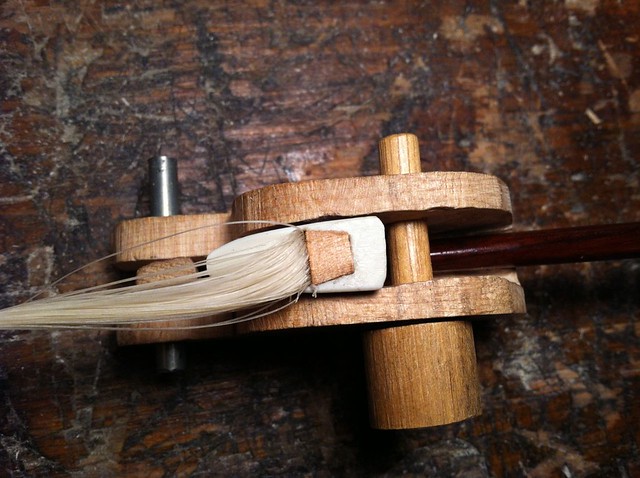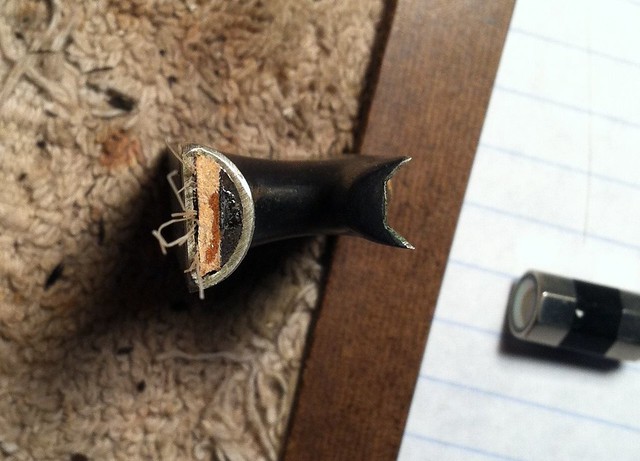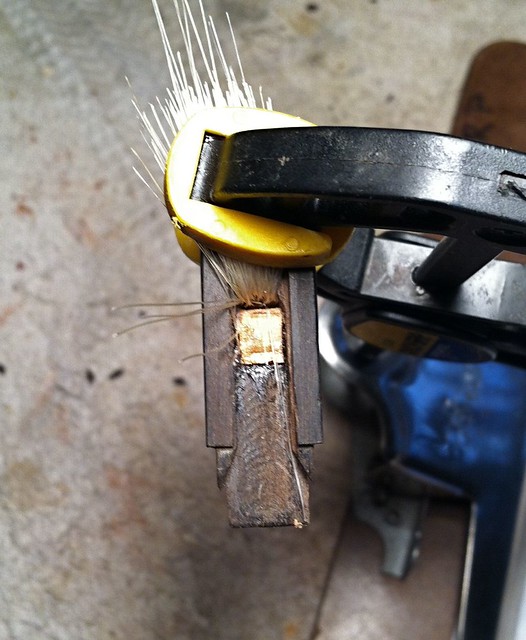Rehairing bows is something that most violin shops do. I do a few a month, in addition to violin repairs and making. It can be challenging, and humbling. Horse hair is used, which is organic and therefore variable. It has to be fit to the right length for each individual bow, and the length of hair changes with humidity and temperature. Not much, but even that can be too much in some situations. I try not to rehair on really rainy days, if I get the choice.
Another part of rehairing is the replacement of three little pieces of wood that are used to hold the hair in place. We are seeing more and more student bows done with, how shall we say?, not so much attention paid to these three little plugs. After all, the customer seldom sees them.
So, here are a few photos of the plugs of a recent rehair.
Here is the tip plug of a student-level violin bow. When done correctly, the plug is just the right size, held in by geometry. This one had a little glue to help it stay in place. Using the traditional invoked cursing 1-10 scale, 1 being none, 10 being the point at which you really need to repent later, this was about a 3.
Here is the ferrule wedge. It's not the best fitted one I've seen, but it did its job.
This plug holds the hair spread and is typically lightly glued in. You can see some of the glue that did not get wiped off. This one actually came apart fairly easy. Invoked cursing: 1.
For one that was rather loosely fit into the ferrule on the end, someone did take a little time shaping it. I'm not convinced this sort of shaping does much better than a straight taper, but it's pretty.
Here is a plug in the frog, holding the hair in that end. The clamp
holding the hair out the way is only for the photograph. This block,
when properly cut, stays in place through geometry and tension. As with many factory bows, this one
had a little glue in place for insurance. It's a little tougher to get out, due to its depth and the nearby edges. Invoked cursing 4 on this one. It came out without too much trouble after a bit of digging.
You can also notice the cutter marks showing in the cut-out of the throat.
And at the upper end, particularly the upper right, you can see a bit of roundness in the mortise. This is from the drill that was originally used to cut the mortise. The mortise should be rectangular, and it's ok to start with a circular hole, but you want to make it nice. This one was mostly rectangular, needing only a little cleaning up.
On the cheapest bows, it is a circular hole, with a piece of dowel glued in, instead of a shaped plug; invoked cursing 11. I try to remember which ones are like that, what they look like from the outside, and simply turn them down on a rehair. These Chinese bows often wholesale in the US at the $10-$20 dollar range and are sold in some stores at $70-$150. But, hey, they're real wooden bows.
What kind of wood? Dunno. But wood they are. Yup.
Wednesday, December 3, 2014
Subscribe to:
Post Comments (Atom)





No comments:
Post a Comment